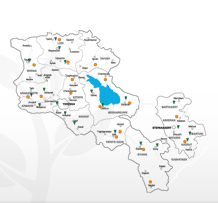Fish factories and processing
Commercial fish farming in Armenia started in the 1950s in the Lake Sevan area, with the construction of hatcheries for Sevan trout and coghak. Further development was the construction of pond farms for production of table fish, mainly carp species (common, bighead, silver) and trout. The farms were big, normally hundreds of hectares, and mostly constructed in areas with salty soils (poor land unsuitable for other agriculture). Water was pumped from rivers. In the 1980s, the effects of pollution reduced the wild catch of fish, and in some cases also negatively affected the health of fish in ponds. Nevertheless, in this period, pond farms produced 5–6 000 t/year. After independence, energy costs rose tremendously, the wells had an important additional advantage: no energy is required to get the water into the ponds. Consequently the state farms that produced cheap fish (mostly carp) at high cost (due to pumping) were supplanted by private farms producing more expensive fish (mostly trout species) using cheap, clean well water. Significant amount of the sturgeon and trout caviar is imported.











